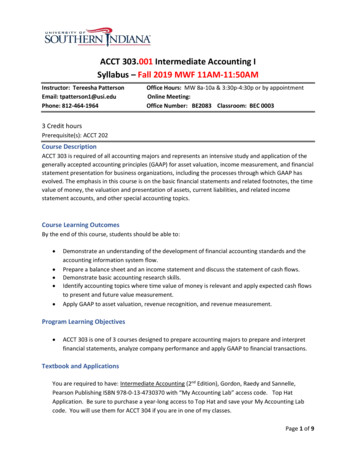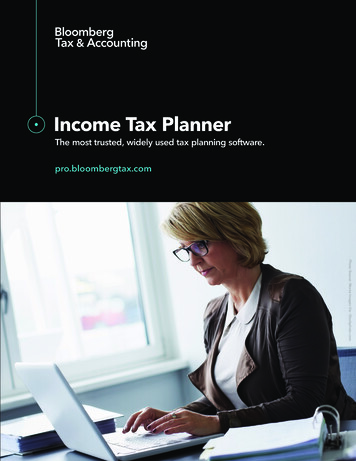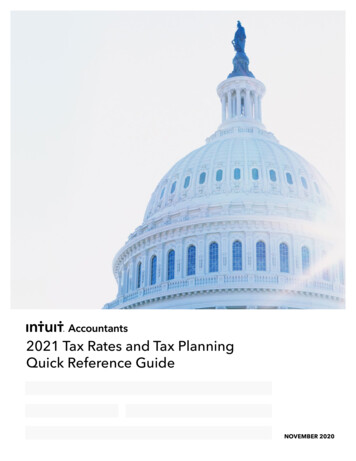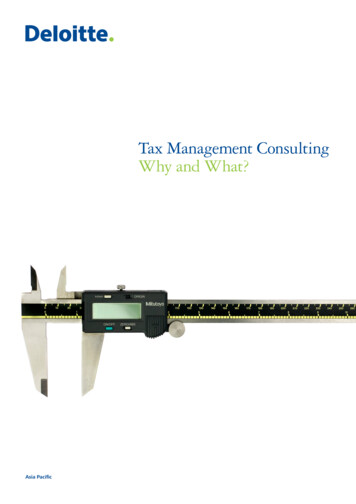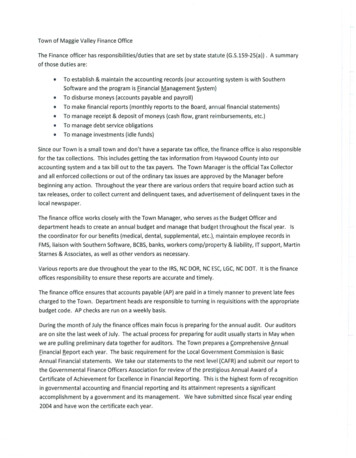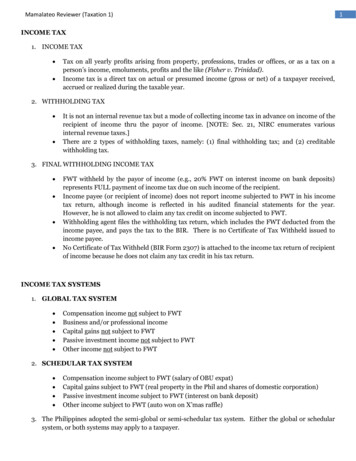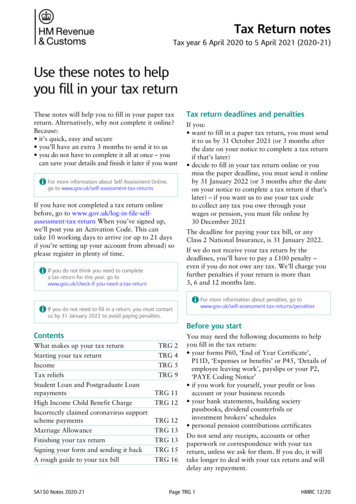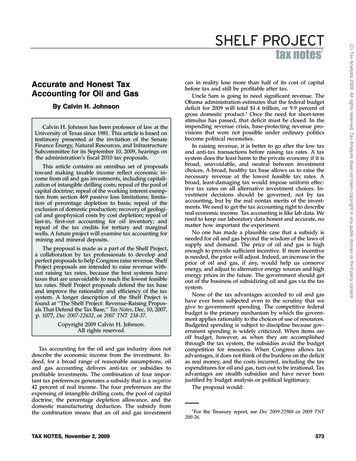
Transcription
tax notesAccurate and Honest TaxAccounting for Oil and GasBy Calvin H. JohnsonCalvin H. Johnson has been professor of law at theUniversity of Texas since 1981. This article is based ontestimony presented at the invitation of the SenateFinance Energy, Natural Resources, and InfrastructureSubcommittee for its September 10, 2009, hearings onthe administration’s fiscal 2010 tax proposals.This article contains an omnibus set of proposalstoward making taxable income reflect economic income from oil and gas investments, including capitalization of intangible drilling costs; repeal of the pool ofcapital doctrine; repeal of the working interest exemption from section 469 passive loss limitations; limitation of percentage depletion to basis; repeal of theexclusion of domestic production; recovery of geological and geophysical costs by cost depletion; repeal oflast-in, first-out accounting for oil inventory; andrepeal of the tax credits for tertiary and marginalwells. A future project will examine tax accounting formining and mineral deposits.The proposal is made as a part of the Shelf Project,a collaboration by tax professionals to develop andperfect proposals to help Congress raise revenue. ShelfProject proposals are intended to raise revenue without raising tax rates, because the best systems havetaxes that are unavoidable to reach the lowest feasibletax rates. Shelf Project proposals defend the tax baseand improve the rationality and efficiency of the taxsystem. A longer description of the Shelf Project isfound at ‘‘The Shelf Project: Revenue-Raising Proposals That Defend the Tax Base,’’ Tax Notes, Dec. 10, 2007,p. 1077, Doc 2007-22632, or 2007 TNT 238-37.Copyright 2009 Calvin H. Johnson.All rights reserved.Tax accounting for the oil and gas industry does notdescribe the economic income from the investment. Indeed, for a broad range of reasonable assumptions, oiland gas accounting delivers anti-tax or subsidies toprofitable investments. The combination of four important tax preferences generates a subsidy that is a negative42 percent of real income. The four preferences are theexpensing of intangible drilling costs, the pool of capitaldoctrine, the percentage depletion allowance, and thedomestic manufacturing deduction. The subsidy fromthe combination means that an oil and gas investmentTAX NOTES, November 2, 2009can in reality lose more than half of its cost of capitalbefore tax and still be profitable after tax.Uncle Sam is going to need significant revenue. TheObama administration estimates that the federal budgetdeficit for 2009 will total 1.4 trillion, or 9.9 percent ofgross domestic product.1 Once the need for short-termstimulus has passed, that deficit must be closed. In theimpending revenue crisis, base-protecting revenue provisions that were not possible under ordinary politicsbecome political necessities.In raising revenue, it is better to go after the low taxand anti-tax transactions before raising tax rates. A taxsystem does the least harm to the private economy if it isbroad, unavoidable, and neutral between investmentchoices. A broad, healthy tax base allows us to raise thenecessary revenue at the lowest feasible tax rates. Abroad, least-damaging tax would impose uniform effective tax rates on all alternative investment choices. Investment decisions should be governed, not by taxaccounting, but by the real nontax merits of the investments. We need to get the tax accounting right to describereal economic income. Tax accounting is like lab data. Weneed to keep our laboratory data honest and accurate, nomatter how important the experiment.No one has made a plausible case that a subsidy isneeded for oil and gas beyond the wisdom of the laws ofsupply and demand. The price of oil and gas is highenough to provide sufficient incentive. If more incentiveis needed, the price will adjust. Indeed, an increase in theprice of oil and gas, if any, would help us conserveenergy, and adjust to alternative energy sources and highenergy prices in the future. The government should getout of the business of subsidizing oil and gas via the taxsystem.None of the tax advantages accorded to oil and gashave ever been subjected even to the scrutiny that wegive to government spending. The competitive federalbudget is the primary mechanism by which the government applies rationality to the choices of use of resources.Budgeted spending is subject to discipline because government spending is widely criticized. When items areoff budget, however, as when they are accomplishedthrough the tax system, the subsidies avoid the budgetcompetition for resources. When Congress allows taxadvantages, it does not think of the burdens on the deficitas real money, and the costs incurred, including the taxexpenditures for oil and gas, turn out to be irrational. Taxadvantages are stealth subsidies and have never beenjustified by budget analysis or political legitimacy.The proposal would:1For the Treasury report, see Doc 2009-22988 or 2009 TNT200-26.573(C) Tax Analysts 2009. All rights reserved. Tax Analysts does not claim copyright in any public domain or third party content.SHELF PROJECT
COMMENTARY / SHELF PROJECT8. Repeal the tax credits. There is a 15 percent taxcredit for enhanced oil recovery projects and a taxcredit of 3 per barrel for marginal wells. Neithercredit is now available because the price of oil hasrisen high enough to give adequate incentive. Thecredits should be repealed while they have noeffect. Indeed the lesson extends beyond the credits:The price of oil is high enough to give adequateincentive. No tax advantages are needed or appropriate.2. Repeal the pool of capital doctrine. Under thepool of capital doctrine, a drilling enterprise maypay many of the costs of drilling by giving out aneconomic interest in the well, without either theenterprise or the provider of goods or servicespaying tax. An accounting system can describe realIRR and impose tax at the statutory tax rates only ifthe adjusted basis of the investment is equal todiscounted present value of the investment. Payingfor royalties and goods and services with carriedinterests should be considered to be a taxableexchange of the underlying assets, both to the payerand to the recipient.A. Fundamentals of Tax Economics for Oil and Gas2Oil and gas transactions commonly benefit from anegative tax or subsidy — that is, the IRR is higher for theinvestment after tax than before tax. This section presentsa simple illustration that takes into account four taxpreferences: expensing of intangible drilling costs, thepool of capital doctrine, percentage depletion, and domestic production exclusions. In the illustrative investment, tax adds 41 percent to the value of the investmentand also allows investments to go forward that destroyover half their cost of capital. All of the tax advantagesare subject to conditions and restrictions, which arediscussed in the section that follows the example.3. Repeal the working interest exemption frompassive activity loss (PAL) limitations. The TaxReform Act of 1986 was able to reduce maximumtax rates from 50 percent to 28 percent, but onlybecause the PAL limitations so effectively attackedtax shelters as they were then known. The passiveactivity limitations remain the most effective of theantishelter tools. The exemption for working interests in oil and gas property should be ended.4. Limit percentage depletion to basis. Percentagedepletion allows the deduction of imaginary costsbecause it continues even after real costs have beenfully deducted. This accounting error was adoptedbecause of an error in identifying ‘‘capital’’ to berecovered as the value of a gold mine when discovered, rather than its much lower cost.5. Repeal the exclusion for domestic production. Sixpercent of income from oil and gas extracted in theUnited States or the continental shelf is excludedfrom tax. The exclusion is part of the reason whythe tax rate on oil and gas investments is negativeand why money-losing investments are enteredinto for the tax benefits.6. Recover geological and geophysical (G&G) costsunder cost depletion. Current law allows the G&Gcosts of identifying promising properties over twoyears, but a producing oil deposit found by thesurveys can last for 30 years.7. Repeal the last-in, first-out inventory accounting.LIFO accounting allows a taxpayer to keep in basisthe oldest and lowest costs since the inventoryaccounts began. To reflect economic income, basisshould come as close to fair market value as possible. First-in, first-out should be mandated for oiland gas inventories. The Obama administration hasproposed eliminating LIFO accounting in its 2010proposed budget.5741. Soft money investing means tax exemption for drilling. The ability to deduct an investment immediatelyordinarily means that tax does not reduce the taxpayer’spretax return from the investment. Getting into an investment with a deduction or exclusion is ‘‘soft moneyinvesting’’ and it means tax does not reduce the amountavailable. Soft money investing is ordinarily of the samevalue as the exemption from tax for the profit or gain.This concept is routine to tax economics but is notcommonly evident in statutory or judicial decisionmaking.Assume a taxpayer, described in Table 1, has 100 ofincome that will be invested in drilling for oil. Theinvestment will triple in some unstated period. Theassumed tax rate is 33.3 percent. Exemption of the returnis described in Column A of Table 1, and soft moneyinvesting is described in Column B.Column A describes the after-tax result if the investment is capitalized, but the gain from the investment isexempt from tax. Capitalization of the investment isnormal in an income tax because an investment is not aloss. Because of capitalization, there is immediate tax onthe 100 of income, which reduces the amount availablefor investment to two-thirds. The amount invested thentriples to 200. Our assumption in Column A, however, isthat there is no tax on the tripling so that the end resultcapitalization and exemption in Column A is 200.An income tax would also ordinarily tax the gain inColumn A. Under normal income tax rules, the gain inthe tripling, 133.33, would be subject to a one-third tax(or 44.44), which would reduce the after-tax proceeds to 155.55. Tax of both the investing and the return is2This analysis of the economics of oil and gas taxation restsheavily on Calvin H. Johnson, ‘‘Capitalize Costs of SoftwareDevelopment,’’ Tax Notes, Aug. 10, 2009, p. 603, Doc 2009-15569,or 2009 TNT 151-9, including some identical paragraphs.TAX NOTES, November 2, 2009(C) Tax Analysts 2009. All rights reserved. Tax Analysts does not claim copyright in any public domain or third party content.1. Repeal the expensing of intangible drilling costs.Drilling for oil or gas is an investment, properlytreated as a capital expenditure. But under currentlaw, the investment is treated as a worthless expense and is deductible when made. Immediateexpensing for an investment means that tax doesnot reduce the pretax internal rate of return (IRR)from the investment. The economic or effective taxrate on a drilling investment has an expected valueof zero.
COMMENTARY / SHELF PROJECTTable 1. Tripling Is Tax Exempt1. Income at 1002. Tax on row 1 at 35percent3. Investable amount(row 1 - row 2)4. Investment (row 3)triples5. Basis6. Taxable amount7. Tax at one-third ofrow 68. End result(row 4 - row 7)(A)CapitalizedInvestment(B)Soft MoneyExpensed orExcluded 100 100- 33 0 67 100 200 300 67 133 0 300Tax exempt- 100 200 200In Column B, the 100 is an intangible drilling cost andthe taxpayer is able to deduct the entire cost immediately.Because of the deduction, none of the 100 of income istaxed. The full income of 100 may thus be invested. InColumn B there is no exemption for the tripling. Still, theresult in Column B is the same, 200, as in Column A withno tax on the profit. Therefore, the ability to expense theinvestment immediately is as valuable as a privilege ofpaying no tax on the gain.Effective tax rate measures how much tax reduces thepretax IRR from the investment.3 The effective tax rate inColumn A is zero because tax does not reduce the triplingbefore tax, and the effective tax rate in Column B is zerobecause tax has the same impact as in Column A.The results of Table 1 can be generalized by algebra,provided the tax rate at the start of the investment (row2) is the same as at the end (row 7), the pretax return(tripling here) is the same on both columns, and theamount invested is sensitive to the upfront tax cost inrow 2:Terminal Value, Exempt Yield, and Expensed(A) Exempt income(B) Expensed investment (column A)(column B) 100 * (1-0) * (1 R)n * 100 * (1-t) * (1 R)n * (1-0)(1-t)Where 100 is unit investment, t is tax rate, (1 R)n iscompound growth at rate R over n, and (1-0) denotes no tax.The equivalence is an application of the commutativelaw of the multiplication, which says that the order in3Effective tax rate (IRRpretax - IRRposttax)/IRRpretax.which (1-t) and (1-0) appear does not matter. The equivalence of yield exemption and expensing is often called theCary Brown thesis.4The Column B model was set up to describe theportion of the investment qualifying as intangible drilling cost. Column B, however, also describes the results ofthe pool of capital doctrine, or the results of a mixture ofthe pool of capital doctrine and expensing of intangibledrilling costs. The pool of capital doctrine, as discussedbelow, allows an enterprise to pay for goods and servicesput into a drilling venture by giving factor suppliers aneconomic interest in the well. If the supplier or royaltyreceiver is willing to take payment for value delivered inthe form of an interest in the outcome of the oil well,there is no tax on the venture at row 2, before investment.Capitalized investments, under an income tax regime,require a reduction by tax before the investment may bemade (row 2 of Column A, Table 1), but paying withuntaxed interests allows enterprise to invest without tax(row 2 of Column B).A corollary of the Cary Brown thesis is that you candeduce how much tax reduces the pretax interest or IRRby looking to the ratio of adjusted basis to nontax fairmarket value.5 Some companies have a tax basis near orabove their FMV and thus they pay effective tax rates ator above statutory tax rates. Companies, including oilcompanies have a basis that is a small fraction of theirvalue and so have modest effective tax rates. The impactof the differential real tax rates throughout the tax systemis that tax warps the pretax value of an investmentderived from real customer demand, and shifts investment to lower utility projects. The wide divergence inreal tax rates, across the system, means that tax isdamaging the allocation of capital unnecessarily.2. Finding economic income.6 A tax system that imposedthe same economic effective tax rate on all investmentswould reduce the harm that the current system now doesto the private economy. Investment decisions should bedriven by the real demand and by costs outside the taxsystem and not by differential tax treatment or taxaccounting misdescriptions. ‘‘Effective tax rate’’ is themeasure of the impact of tax on IRR7:4Cary Brown, ‘‘Business-Income Taxation and InvestmentIncentives,’’ in Income, Employment and Public Policy: Essays inHonor of Alvin H. Hanson, 300 (1948).5Calvin H. Johnson, ‘‘The Effective Tax Ratio and the Undertaxation of Intangibles,’’ Tax Notes, Dec. 15, 2008, p. 1289, Doc2008-24799, 2008 TNT 242-46. A soft money investment (S) (e.g.,in Column B of Table 1) can be 1/(1-T) the size of a capitalizedinvestment (H for hard money), where T is the statutory taxrate. The effective tax rate is(pretax return - post tax return)/ pretax returnor{(H S)*R - [H S/(1-T)] * R * (1-T)}/(H S)*R H/(H S) * Twhere H is basis and H S is pretax value.6The section is based on Paul Samuelson, ‘‘Tax Deductibilityof Economic Depreciation to Insure Invariant Valuations,’’ 72 J.Pol. Econ. 604 (1964).7There are other definitions of ‘‘effective tax net rate’’ relatedto the IRR-reducing rate explained in the text. ‘‘Effective tax’’ is(Footnote continued on next page.)TAX NOTES, November 2, 2009575(C) Tax Analysts 2009. All rights reserved. Tax Analysts does not claim copyright in any public domain or third party content.implied by our treatment of debt financing, which givesboth a deduction for interest and basis or exclusion forprincipal. Within an income tax, avoiding the tax on gainis recognized as a benefit.
COMMENTARY / SHELF PROJECTEffective tax rate (IRRpretax - IRRposttax)/IRRpretaxYear0 100 100 100 100 10012345( 379)The investment gives a 10 percent interest-like IRR peryear before tax because the 379 is the present value ofthe five 100 cash flows at 10 percent under the standardformula for present value of an annuity:(1) 379 100 *1- (1 10%)-n10%using i (discount rate) of 10 percent and n (number ofyears) of 5.8The Cary Brown thesis that expensing is equivalent tono tax reduction of the pretax return can be restatedsometimes used to refer to the total overall tax divided byoverall income, in contrast to the ‘‘marginal tax rate,’’ whichlooks to the tax on the next dollar of change in income.8The standard annuity formula is a shortcut, derived byseries analysis, from the separate discounting of each 100 fordifferent year, at the standard formula for present value, e.g., 100/(1 i)n.576(2) 379 * (1 - T) 100 * (1 - T) *1 - (1 10%)-n10%Equation (2), the expensing case, becomes identical tothe pretax situation, equation (1), when the tax of (1 - T)is factored out of both sides of equation (2). The returnrate i is the same 10 percent both pretax (equation (1))and post tax (equation (2)).If we are to tax the 10 percent return in the investment,by contrast, and reduce the interest by the statutory taxrate, we would have to identify the interest earned everyperiod. Table 2 on the following page analyzes theillustrated investment as if it were a bank account, givingthe 10 percent interest rate. All investments are measuredas if they were bank accounts because that is the universal yardstick by which very diverse investments aremeasured.To identify the interest or IRR, it is necessary toidentify the bank account balance on which the interest iscalculated and keep that balance as part of adjusted basis.Table 2 assumes an investment of 379 in an oil and gasoperation that returns pretax 100 or 10 percent interest ayear for five years.In Table 2, each year the bank account earns interest atthe built-in 10 percent interest rate (identified in row 3).But the interest is not enough to cover the withdrawalsfrom the bank account — that is, the cash flow revenue inrow 1 — so some part of each withdrawal is a reductionof the bank account balance by the amount of row 4. Therow 4 withdrawals in excess of interest reduce the bankaccount balance to zero at the end of the term. The bankaccount balance (row 2) is always net present value ofremaining revenue at the 10 percent IRR. Depreciation orrecovery of basis is the drop in the bank account balanceshown by row 4. If we tax the interest income identifiedin row 2 at 35 percent, the tax system will reduce the IRRfrom 10 percent to 10% * (1 - 35%) or 6.5 percent, whichis the after-tax income implied by a 35 percent tax on 10percent interest income. The present values of the aftertax cash flows (row 7) sum to zero showing that theinvestment, under the tax of row 6, is like a bank accountgiving IRR or interest of 6.5 percent. Different investments will have different row 1 pretax cash flows, but ifthe depreciation and adjusted basis describe the incomefrom the investment, the adjusted basis will equal netpresent value of the future cash flows from the investment at the IRR.The adjusted basis that will identify the IRR can becalculated from net present value when future cash flowsare assumed, as in the illustration, or when there is abroad market that sets a market price using estimates offundamental value like the Table 2 analysis. More generally, however, the future cannot be known. Tax accounting must use conventions approximating FMV basis to beadministrable on a national basis with low audit rates.Still, the theoretical norm of what tax accounting wouldlook like if we did tax the economic income provides apurpose or goal for tax accounting. Accounting rules andTAX NOTES, November 2, 2009(C) Tax Analysts 2009. All rights reserved. Tax Analysts does not claim copyright in any public domain or third party content.IRR is a universal yardstick for comparing diverseinvestments. It is the interest rate on a hypothetical bankaccount that is like the investment under examination.The impact of tax on that interest-like IRR is the measureof the real impact of tax, whatever the nature of theinvestment and whatever the manner or time ofcomputation of the tax or the nominal statutory tax rate.The formula for effective tax rate, above, asks how muchtax has dropped the IRR and then takes that drop as apercentage of the pretax IRR. Imposing the sameeffective tax rate on investments across the economyprevents property from being worth more to highbracket taxpayers than low-bracket taxpayers, andprevents tax from distorting the pretax choice of what isa good investment.To impose a uniform effective tax rate, accountingmust identify the interest-like IRR from the investmentand subject it to tax. Tax accounting identifying IRR isforced, for instance, by our treatment of debt, whichallows a deduction of interest and respect for theprincipal of the debt, which is the mirror image oftreating the investment as a bank account. A neutral taxaccounting that describes and taxes economic incomewould keep the adjusted basis for an investment equal tothe net present value of the investment, using IRR as thediscount rate to determine net present value.Assume, for example, an oil and gas venture has cashflows set to give a 10 percent return over five years in theabsence of tax.simply from equation (1) because expensing would bothreduce the after-tax cost of the 379 investment by rate T,and tax would also reduce the 100 revenue by T:
COMMENTARY / SHELF PROJECT012345- 379 100 100 100 100 100 379 317 249 174 91 0- 379.08 37.91 31.70 24.87 17.36 9.09 62.09 68.30 75.13 82.64 90.91 317 13.27 86.73 249 11.09 88.91 174 8.70 91.30 91 6.07 93.93 0 3.18 96.82 81.44 78.38 75.58 73.01 70.67Table 3. Internal Rate of Return After Four Tax Preferences(Intangible Drilling Costs, Pool of Capital, Percentage Depletion, and Domestic Production)Year1. Pretax cash flows, set up to give 10 percent IRR2. Row 1 minus 15 percent depletion allowance3. Row 1 minus 6 percent of row 2 for domestic manufacturingexclusion4. Tax on row 3 at 35 percent5. Expensing of row 1 saving tax at 35 percent6. After-tax cash flow (row 1 minus row 4 or row 5)7. Present value at found 14.2 percent IRR (row 6 / (1 IRR)n).Row 7 sums to zero at found 14.2 percent rateconventions that leave the taxpayer with an adjustedbasis closer to net present value of future cash flows aremore accurate than accounting rules and conventionsthat leave the adjusted basis further away from netpresent value. The pool of capital doctrine and intangibledrilling expensing fail to reflect economic income because they drop the taxpayer’s basis in the investmentbefore the net present value of future cash flows.3. Combining subsidies: negative tax. Investments in oiland gas can sometimes qualify not only for the upfrontsoft money investing benefits of expensing and pool ofcapital doctrine, but also for subsequent exclusions ofrevenue under percentage depletion and domestic production allowances. As discussed below, section 613allows independent oil companies to exclude 15 percentof revenues from oil, and section 199 allows taxpayers toexclude 6 percent of earnings from domestic oil and gasproduction. Assume for Table 3, above, the same pretaxinvestment discussed in Table 2 but assume soft moneyinvesting at the outset and the exclusions for percentagedepletion and domestic production.The after-tax cash flows in row 6 of Table 3 have anIRR of 14.2 percent because 14.2 percent will sum the netpresent value of all the cash flows to zero. The 14.2percent figure is the interest on a bank account that couldgive the cash flows equal to those in row 6. Tax hasimproved the investment from 10 percent before tax to14.2 percent after tax. The improvement is a negative taxrate or a subsidy of 42 percent of the original income.Table 3 is undoubtedly a temporary advantage because competitors will move in when the return rate is so012345- 379 100 85 100 85 100 85 100 85 100 85 80 80 80 80 80 28 28 28 28 28- 133- 246 72 72 72 72 72- 246 63 55 48 42 37high. In equilibrium, returns drop on investments in acompetitive economy, so that they have an annual returnafter tax equal to the cost of capital. Assume somecompetitor can borrow at 10 percent (same as return rate)and deduct the interest so that after-tax cost of interest is10% * (1 - 35%) or 6.5 percent. Table 4, on the followingpage, shows that given the tax benefits, the competitorcan make as little as 87 a year or 4.9 percent return andstill have enough to bear the costs of interest. The pretaxcash flows in row 1 of Table 4 yield a return of only 4.9percent annually.9 The investment in Table 4 in making4.9 percent, loses 51 percent of its real interest cost at 10percent in the absence of tax. Tax policy has givensufficient incentive to allow a wasteful investment.Allowing an investment like that shown in Table 4wastes capital. The assumed cost of capital is 10 percentand the annual return of 4.9 percent wastes 51 percent ofthe cost. Absent showing of special merit in the budgetprocess, a pretax money-losing investment is a badinvestment that should not be made.If the advantage of a low tax rate or a subsidy from theoil and gas preferences is passed on to customers, customers get a false sense of the true costs of oil and theyadapt to the falsely cheap prices by overconsumption.Cheap oil to consumers is especially dangerous nowbecause we rely on foreign sources from dangerous parts9The 4.9 percent figure is the discount rate that makes costsand revenues have the same future value, hence 4.9 percent isthe IRR from the investment:(Footnote continued on next page.)TAX NOTES, November 2, 2009577(C) Tax Analysts 2009. All rights reserved. Tax Analysts does not claim copyright in any public domain or third party content.Table 2. Economic Depreciation — Five-Year, 10 Percent InvestmentYear1. Revenue to give 10 percent IRR2. Adjusted basis, bank account balance, net present valueof future revenue at IRR3. Interest at 10 percent on bank account (prior year row2), also income4. Withdrawal in excess of interest earned (aka recovery ofbasis or depreciation) (row 1 minus row 3)5. New bank account balance (row 2 minus row 4)6. Tax on row 3 at 35 percent7. After-tax cash flow (row 1 minus row 6)8. Present value at found 6.5 percent [row 6/(1 6.5%)n].Row 7 sums to zero at 6.5 percent
COMMENTARY / SHELF PROJECTYear1. Pretax cash flows with a found revenue to yield enough topay interest cost2. Row 1 minus 15 percent depletion allowance3. Row 1 minus 6 percent of row 2 for domestic manufacturingexclusion4. Tax on row 3 at 35 percent5. Expensing of row 1 saving tax at 35 percent6. After-tax cash flow (row 1 minus rows 4 and 5)7. Present value at debt cost 6.5 percent IRR (row 6 / (1 IRR)n).Row 7 sums to zero at 6.5 percent discount rateof the globe for our supply,10 and because the overconsumption of oil contributes to global warming. Cheap oilundercuts conservation and the development of alternative energy sources. Consumers have to start to adapt tothe future when oil will become very expensive, becausethe adaptation will take considerable time.If the subsidy from tax preferences for oil is not passedon to customers, the subsidy just contributes to the networth of taxpayers holding oil interests. Given the desperate need for revenue, a basic sense of fairness suggeststhat those with the equal ability to pay tax should payequal taxes whether they are in oil or some other economic activity.Ending the tax preference subsidies to the extractiveindustries would improve the efficiency of consumerchoices because prices will then reflect real, unsubsidizedcosts. In a capitalist system, the decisions reached bysupply and demand and evidenced in unsubsidized priceare presumed to represent the best decisions about use ofour limited resources. If Congress decides to subsidize oiland gas investments, it should do so only by way of acompetitive budget process for government spending.B. Proposed Reforms of Oil and Gas Tax PreferencesThis section describes the most important tax preferences available for oil and gas investments under currentlaw, the reasons for change, and the remedy proposed.1. Soft money, upfront benefits.a. Intangible drilling costs. Under current law, ataxpayer may deduct the costs of drilling for oil, as if itwere a worthless or lost cost as soon as it is made, evenwhen the drilling program is highly successful.11 Thededuction arises from a congressional resolution adoptedto reverse a Fifth Circuit holding that intangible drillingcosts were indeed investments and capital expendi-1-(1 i)-niusing i (discount rate) of 4.9 percent and n (number of years) of5.10See, e.g., William M. Vandenburgh, ‘‘Raise Federal Gas TaxNow or Pay OPEC Later,’’ Tax Notes, Jan. 26, 2009, p. 533, Doc2008-26834, or 2009 TNT 15-48 (arguing for increased tax on oiland gas to reduce dependence on foreign oil).11Section 263(c).(1) 379578 87.24 *012345- 379 87 87 87 87 87 85 85 85 85 85 80 80 80 80 80 28 28 28 28 28- 133- 246 72 72 72 72 72- 246 63 55 48 42 37tures.12 Costs eligible for expensing under section 263(c)must be costs that cannot be salvaged when the drillingis over.13 An integrated oil company must reduce itsexpensed
Nov 02, 2009 · A. Fundamentals of Tax Economics for Oil and Gas2 Oil and gas transactions commonly benefit from a negative tax or subsidy — that is, the IRR is higher for the investment after tax than before tax. This section presents a simple illustration that takes into account four tax
